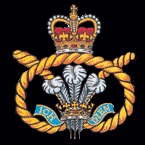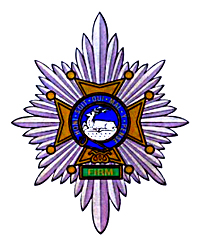Related Research Articles

The Infantry of the British Army, part of the structure of the British Army, comprises 49 infantry battalions, from 19 regiments. Of these, 33 battalions are part of the Regular army and the remaining 16 a part of the Army Reserve. The British Army's Infantry forms a highly flexible organisation, taking on a variety of roles, including armoured, mechanised, air assault and light.

The Staffordshire Regiment was an infantry regiment of the British Army, part of the Prince of Wales' Division. The regiment was formed in 1959 by the amalgamation of the South Staffordshire Regiment and the North Staffordshire Regiment, and in 2007 was amalgamated with the Cheshire Regiment and the Worcestershire and Sherwood Foresters Regiment to become the 3rd Battalion, Mercian Regiment.

The Mercian Regiment is an infantry regiment of the British Army, which is recruited from five of the counties that formed the ancient kingdom of Mercia. Known as 'The Heart of England's Infantry', it was formed on 1 September 2007 by the amalgamation of 3 existing regiments. The Regiment has had eight operational deployments since its formation.

The Worcestershire and Sherwood Foresters Regiment was an infantry regiment of the British Army, part of the Prince of Wales' Division. The regiment served as the county regiment for Derbyshire, Nottinghamshire and Worcestershire.

The King's Division is a British Army command, training and administrative apparatus designated for infantry regiments in the North of England.

The Prince of Wales's Division was a British Army command, training and administrative apparatus designated for all land force units in the West of England and Wales. It merged with the Scottish Division, to form the Scottish, Welsh and Irish Division; at the same time the Mercian Regiment joined with the King's Division.
The Lowland Brigade is a historical unit of the British Army which has been formed a number of times. It is traditionally Scottish as the name derives from the Scottish Lowlands.
The West Midlands Regiment was a short-lived British Territorial Army regiment from 1999, until it was re-designated as 4th Battalion, Mercian Regiment, in 2007.
The Wessex Brigade was an administrative formation of the British Army from 1948 to 1968. The Brigade administered the regular infantry regiments of the Wessex area of south and south west England.
The Home Counties Brigade was an administrative formation of the British Army from 1948 to 1968. The Brigade administered the regular infantry regiments of the Home Counties of south east England.
The East Anglian Brigade was an administrative brigade of the British Army from 1946 to 1968, that administered the regiments with recruiting grounds in East Anglia, and the East of England.
The Forester Brigade was an administrative formation of the British Army from 1948 to 1964. The Brigade administered the regular infantry regiments of the English Midlands.
The Welsh Brigade was an administrative formation of the British Army from 1948 to 1964. The Brigade administered the regular Welsh infantry regiments.
The Lancastrian Brigade was an administrative formation of the British Army from 1948 to 1968. The Brigade administered the regular infantry regiments of northwest England.
The Yorkshire Brigade was an administrative brigade formation of the British Army from 1948 to 1968. The brigade administered the regular infantry regiments of Yorkshire, England.
The Light Infantry Brigade was an administrative formation of the British Army from 1948 to 1968. The Brigade administered the regular English light infantry regiments.

The North Staffordshire Regiment was a line infantry regiment of the British Army, which was in existence between 1881 and 1959. The 64th Regiment of Foot was created on 21 April 1758 from the 2nd Battalion of the 11th Regiment of Foot. In 1881, under the Childers Reforms, the 64th Regiment of Foot was merged with the 98th Regiment of Foot to form the Prince of Wales's . In 1921 the regimental title was altered to the North Staffordshire Regiment .
A large regiment is a multi-battalion infantry formation of the British Army. First formed in the 1960s, large regiments are the result of the amalgamation of three or more existing single-battalion regiments, and perpetuate the traditions of each of the predecessor units.
The 98th Regiment of Foot was an infantry regiment of the British Army. It was originally raised in 1824 as the 98th Regiment of Foot, before assuming the title of the 98th Regiment of Foot in 1876. Later, in 1881, following the Childers Reforms of the British Army, the regiment was amalgamated with the 64th Regiment of Foot to become the Prince of Wales's Regiment. As the 64th Foot was senior to the 98th, the 98th became the 2nd Battalion in the new regiment. Throughout the course of the regiment's existence it served mostly overseas in South Africa, China and India.
The Mercian Volunteers was a Territorial Army infantry regiment of the British Army, in existence from 1967 to 1988. Upon formation, it consisted of a singular battalion, however it later raised a second in 1975.
References
- ↑ Messenger, Charles (16 March 1994). A History of British Infantry: For Love of Regiment, Volume 2, 1915-1994. p. 156. ISBN 9780850524222.
- ↑ Whitaker's Almanack 1956, p. 471
- ↑ A L King and H L Kipling, Head-dress badges of the British Army, Volume 2, London, 1979
- ↑ Mercian History, (Mercian Volunteers Regimental Association) accessed August 15, 2007 Archived September 29, 2007, at the Wayback Machine
- ↑ Whitaker's Almanack 1969, p. 473